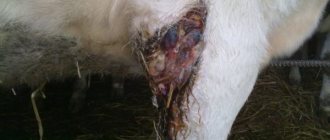Sholicheva Alisa Andreevna veterinary cardiologist
Is it dangerous?
Cyanosis or blueness of visible mucous membranes is always a scary sign! It is not an independent disease, but at the same time, it can be a symptom of several (including life-threatening) diseases.
Why do mucous membranes turn blue?
The color of the mucous membranes depends on the oxygen saturation of the blood. If for some reason a sufficient amount of oxygen does not enter the blood, the mucous membranes acquire a bluish tint. If cyanosis is persistent and the body does not receive the required amount of oxygen for a long time, a serious condition for the animal’s body may develop, even leading to death. Normally, the color of visible mucous membranes is pink (from intense to pale pink). The color is easy to see in the oral cavity: gums, lips, inside cheeks, tongue; if the dog is aggressive and there is no way to open its mouth, you can see the color of the conjunctiva (the inner surface of the eyelid).
The most common causes of cyanosis in dogs
- Pulmonary edema
A very life-threatening condition - requires urgent assistance and immediate treatment to the clinic! In addition to cyanosis, pulmonary edema is also accompanied by other symptoms: incessant shortness of breath, coughing (expectoration of foam and blood), the inability of the animal to lie down, and anxiety. When an animal with such symptoms arrives for an appointment, the doctor will urgently assess the animal’s condition and decide whether to place the animal in the intensive care unit (which is indicated for animals with severe symptoms of respiratory failure). Also, at the very initial stages of diagnosis, it is necessary to determine the nature of the edema - its cause (since this is not an independent disease, but only a clinical manifestation of some hidden problem in the body). An X-ray of the lungs will be required to confirm the diagnosis, determine the severity of the condition and detect a possible cause. To relieve the symptoms of edema and improve the animal’s condition, it will undergo active diuretic (diuretic) therapy. After the animal’s condition has normalized and the cause of pulmonary edema has been identified, the dog should receive treatment for its underlying disease to avoid recurrence of this symptom. - pneumothorax and hydrothorax
Most often occurs as a result of injuries in the chest area, falls from a height, auto injuries, and bites.
Pneumothorax
is an accumulation of air in the chest cavity,
hydrothorax
is an accumulation of fluid. In these conditions, the lungs are unable to fill with air normally, and in some cases, part or one entire lung does not work. If the process of fluid or air entering the chest cavity does not stop, the animal dies from suffocation. If you notice that for some time your animal begins to breathe worse, shortness of breath and cyanosis develop (from several minutes to several days after injury), you need to contact the clinic to exclude these life-threatening conditions! To confirm this diagnosis, the doctor will need to take x-rays. Typically, fluid or air is removed from the chest cavity. The procedure is not complicated and is usually performed under sedation (a small dose of a sedative). It is also necessary to identify the cause of this condition. This may require testing of fluid removed from the chest cavity. Further treatment will be aimed at preventing the onset of symptoms and treating the disease that caused them; in severe cases, surgery is required. - hypertrophy of the velum palatine.
Most common in dogs, the so-called. brachiocephalic breeds (boxers, pugs, bulldogs, Pekingese, etc.). With this pathology, the lumen of the larynx is closed by enlarged tissue of the soft palate, thereby limiting the flow of air into the lungs. Most often, symptoms appear when the animal is excited (joy, stress, pain) and is accompanied by attacks of shortness of breath, up to “respiratory” fainting. Also, such symptoms may increase in these breeds when it is hot. If, upon admission of such an animal to the clinic, its condition is assessed as critical, then the animal is placed in the intensive care unit, where doctors can resume the normal flow of air into the lungs: install a tracheal tube, connect the dog to a ventilator. Often in this case, surgery is indicated - plastic surgery of an enlarged velum and tracheotomy (surgical creation of an opening in the trachea in the neck, bypassing the oral cavity). This hole will be temporary until the dog resumes normal breathing after surgery. Then the hole will gradually close on its own. In rare cases, a dog needs a tracheostomy for life. - collapse (narrowing) of the trachea
This problem most often occurs in dogs of small and toy breeds: Yorkshire Terrier, Shih Tzu, Miniature Poodle, Toy Terrier, etc. The diagnosis is made on the basis of tracheoscopy - a special examination of the trachea from the inside under general anesthesia. A doctor may suspect the presence of this disease if there is a visible narrowing of the trachea on an X-ray of the patient. - congenital heart defects
Owners notice persistent cyanosis in their pets at an early age. The so-called “blue” (causing cyanosis) defects include: atrial septal defect - ventricular septal defect
- a combined defect called tetralogy of Fallot
The incidence of these congenital heart defects in dogs accounts for a very small percentage. To make such a diagnosis, it will be necessary to undergo a full cardiac examination: ECG (electrocardiography), ECHO (ultrasound of the heart) and chest x-ray.
Remember!
The presence of cyanosis always means that the body does not have enough oxygen and there is an excess of carbon dioxide. This is always life-threatening. Your task is to deliver the animal to the clinic as quickly as possible.
Sholicheva Alisa Andreevna
A radiator, a food and water conveyor, a wound healer, a taste recorder, a sensor and a wet version of the greeting handshake. The tongue has so many functions and responsibilities that no other part of the body has, with the exception of the brain, of course. Surprisingly, despite being so busy, this part of the body does not require special care at all.
Recently, my hunter friends invited me to photograph with my camera what they do with their dogs. I used up 4 rolls of film photographing the extraordinary training of three black Labradors. When I started developing the photographs, I was amazed at how many frames there were in which the objects of my photo hunt were captured with their long tongues sticking out and fluttering in the wind (I mean dogs, not their owners). In almost every photograph, the dogs' mouths were gaping so that the oncoming wind could easily enter their mouths, and their tongues were stuck out as far as possible. Seeing the photos made me think. Amazingly, in all my extensive veterinary practice, I have encountered only a couple of cases of tongue damage. But despite the fact that he is almost always outside the mouth, and sometimes flutters like a flag, injuries should happen all the time. However, in my 25 years as a veterinarian, I have very rarely seen injured tongues. Although quite often hunters call me and ask me in a panic to come quickly, because the dog “is just gushing blood from his mouth.” And when I rush as fast as I can to the “wounded” dog, mentally preparing for some unimaginably complex surgical operation, instead of a terrible wound, I find only a couple of lingering scratches. And the owner apologetically reports that “the blood stopped on its own.” Why is this happening?
The thing is that at the moment of injury, which can be inflicted by a thorn, its own teeth, barbed wire or any other sharp object, the dog’s tongue is enlarged and filled with blood. During physical activity, such as running, the blood vessels in the tongue dilate, causing it to swell and fill with blood. And even a small injury at such a moment will cause streams of blood, and with a deep cut, the blood can even flow like a fountain. When the owner notices that the dog is literally bleeding, the hunt naturally stops immediately. And when the dog “cools down” and calms down, the blood flow decreases, that is, it returns to normal again. The tongue shrinks and in this state heals very quickly. So if your four-legged friend pierced his tongue somewhere in a field or swamp in the midst of a hunt, do not panic and do not call a rescue helicopter. Just stop, let your dog rest and take a couple of sips (no more!) of cold water. And if after this the blood still flows like a river, then you will still have to go to the vet.
When giving your dog water to cool his tongue, do not let him drink too much. The movements the tongue makes when lapping will interfere with the blood clotting and healing process. In addition, if the wound turns out to be serious (pah-pah) and the dog needs stitches, it is better that its stomach is empty. The anesthesia may cause vomiting, and the unconscious dog may choke.
Anatomy of the tongue
The tongue is an elongated muscular organ covered with a special epithelium. It performs many functions: it recognizes taste and objects by touch, responds to pain, helps the body get rid of excess heat and avoid overheating.
When I sat down to write this article, I could only remember 3 muscle groups involved in the tongue. I had to turn to an authoritative source - the veterinary encyclopedia. It turned out that as many as eight pairs of muscles help the tongue move! All of them have complex Latin names: genioglossus, hyoepiglottis, sternohyoideus.
But, for example, the hyoid ligament, which holds the tongue in place, is called a frenulum. Your tongue also has a frenulum, you can even see it in the mirror, but it is not as well developed as in dogs. But what humans definitely don’t have is the lingual cartilage (lyssa), which runs along the entire length of the tongue exactly in the middle. It is believed that in ancient times, this small device helped treat various diseases and even rabies. Yes, medicine has come a long way and has come to the modern level of development, at which we have no idea why dogs need, for example, lingual cartilage lyssa.
So, let's begin a detailed study.
Why is my tongue wet?
Every dog has four pairs of salivary glands and small drainage ducts that carry saliva into the mouth. One of the salivary glands is located at the base of the cartilage of the ear canal, the other is located under the cheekbone on the side of the eye. The remaining two are located in front and behind the angular process of the jaw. These glands are responsible for filling the mouth with moisture and produce 2 types of saliva: thick mucus-like saliva and watery serous saliva. In addition, on the surface of the tongue there are small independent salivary glands that secrete both types of saliva. Saliva, evaporating, cools the tongue, that is, it performs the same function as, for example, sweat.
What color is the tongue?
You've probably heard from dog “experts”: “Your dog has a black tongue, which means he has wolf blood!” What nonsense! Absolutely all dogs, from Chihuahuas to Bernese mountain dogs, are descended from wolves. And the differences between the breeds have developed over centuries of selection.
Black pigmentation of the tongue, gums and inner surface of the lips is due to microscopic granules of melanin, is a very common phenomenon and is absolutely harmless to the health of the dog. But if the dark area protrudes slightly compared to the nearby light surface, you need to contact your veterinarian, as such dark lumps can be a sign of a dangerous cancer - melanoma. Another common type of tongue cancer is squamous cell carcinoma. Less common are granular cell tumors or mast cell tumors. If detected early, these cancers can be treated with surgery followed by radiation therapy.
When is blue tongue normal?
Although such an unnatural shade of mucous membranes may signal health problems, there are dog breeds that have a blue tongue as a feature. These are dogs such as Chow Chow, Shar Pei, Eurasier.
Today, the reliable reasons for such an unusual color of the tongue and mucous membrane of these breeds are unknown, but there are also legends on this topic that originated in the homeland of these animals.
If the pet does not belong to the types of dogs described above and its tongue has acquired a blue tint, then it is necessary to urgently show it to the veterinarian, as this indicates the presence of health problems.
Infections
The tongue is very rarely susceptible to infections due to its rich circulatory system. If the infection gets into the tongue, it is only due to injury to it by a foreign object: a fox tail spine, a bird feather, a thorn or a wood chip. Now raise your hands, how many of you often let your pet chew on wooden sticks? Same thing. Keep in mind that a wooden stick, although a lot of fun for your dog, can cause great harm to both the oral cavity and the gastrointestinal tract. There is no need to remind you that wood is not digestible. So throw your pet a tennis ball and forget about the tree.
Get into the good habit of checking your dog's mouth regularly. For example, you can do this every Saturday morning before starting your household chores. Maybe you'll get lucky and find something that will require an urgent visit to the vet and save you from household chores for at least that weekend.
The dog lost his appetite, but his thirst remained
There are many reasons why a dog stops eating food while drinking excess water. For example, diseases of the gastrointestinal tract are indicated. It happens that a dog does not eat during the day, then returns to the bowl again. This is considered normal, but can indicate dehydration.
Observe how much the dog drinks - does not eat, but still drinks, or is it able to drink several bowls of water in a short time? Provided that the animal's diet remains unchanged. If confirmed, the likelihood of difficulties with the kidneys, blood sugar (diabetes) or with the genitals (purulent inflammation of the uterus - pyometra) is noted. In addition to general tests, there is the need to perform an ultrasound of the abdominal cavity to exclude the listed diseases.
Stress or fear can cause loss of appetite. The age of the dog is interesting. When a pet is already old, it is quite capable of refusing food. In addition, eating can be painful.
Nerves
A dog's tongue can do so much! It is helped to perform all these varied and complex functions by five separate pairs of nerves, directly connected to the brain through special openings in the dog’s skull. These nerves are called cranial nerves because they come straight from the base of the brain rather than rising from the spinal cord. I could have become a brilliant photographer if my right index finger was controlled by a cranial nerve instead of an ordinary spinal nerve.
Remember: the tongue is the head of everything. And everything else in the dog’s mouth is just his assistants. Therefore, pay close attention to your dog’s tongue. Check your tongue, gums, and palate regularly for any sores, bruises, bruises, or lumps. Check your mouth for any lumps or broken teeth that could damage your tongue. And don’t forget to look under your tongue—you might find something there that you recently lost.
And let this hot wet tongue lick you once before you go for a walk with its owner, because he rightfully deserves it.
Some dogs (such as chow chows) have a purple tongue that is a congenital feature. If the dog’s tongue and mucous membranes were previously pink and suddenly turned blue, we are talking about cyanosis.
Cyanosis gives a bluish or purple tint to the skin or mucous membranes due to large amounts of hemoglobin that is poorly oxygenated. Oxygenated blood is red. When there is poor oxygen supply, the blood is dark blue.
What does the tongue look like in purebred puppies?
It is noteworthy that dogs of this breed do not get a blue tongue from birth.
For the first month, the oral cavity of puppies is pink, and after that it begins to turn blue, and the older the individual, the more intense the color.
The color can be from blue-black to lilac-blue and can even change depending on the mood and general condition of the dog in the surrounding area. When the dog is worried or stressed, lightening is observed.
Chow chow puppies are born with pink tongues; the color begins to change only a month after birth.
Diseases can also leave some pink areas on it, which will disappear over time. In summer there is also a lighter shade.
The color of the tongue is closely related to the health of any dog.
If a one and a half month old puppy has weak pigmentation of an organ or its spotted color, then there is a possibility of the presence of some diseases. The color of the mouth is the most important sign of the purebred and purebred dog that licked the palate.
Causes
Causes in dogs may include congenital heart disease, various respiratory diseases, and exposure to certain chemicals that lead to the creation of abnormal forms of hemoglobin that are unable to properly bind oxygen.
There are two main types of cyanosis: central
and
peripheral
.
- Central cyanosis
is the result of malfunction of the entire central circulatory system and is caused by a decrease in oxygen levels in the entire circulatory system. All tissues are damaged. - Peripheral cyanosis
occurs in a specific area of the body. Its causes may be hypothermia (low body temperature leads to constriction of blood vessels in the skin); thromboembolism (blood clot that interferes with normal blood flow); use of a tourniquet (accidental, intentional or harmful); shock (insufficient blood flow to tissues).
All animals with central cyanosis also have peripheral cyanosis, because All the blood is not saturated with oxygen. However, there may be peripheral cyanosis without central cyanosis.
In young animals, the most likely cause of central cyanosis is a congenital heart defect, in which the blood partially bypasses the lungs and is not saturated with oxygen due to anatomical disorders in the structure of the heart and blood vessels (tetralogy of Fallot, ventricular and atrial septal defects, patent ductus bollus).
Animals of any age can develop secondary cyanosis due to pulmonary disease (severe pneumonia) or factors that prevent normal expansion of the lungs (fluid or air in the chest cavity). Cyanosis can also be caused by laryngeal paralysis, airway obstruction, diaphragmatic hernia, neurological disorders, pulmonary hypoventilation, respiratory muscle insufficiency, pulmonary embolism, pulmonary edema, acute respiratory distress syndrome, pulmonary fibrosis, neoplasia.
Genetic defects can affect hemoglobin's ability to carry oxygen. However, this defect rarely occurs in animals. Hemoglobin defects are more associated with food intoxication, or exposure to chemicals and oxidizing agents (such as nitrates, nitrites, acetaminophen, etc.).
Cyanosis in dogs is a clinical symptom, and if it occurs, you should immediately take your dog to the veterinarian.
Diagnostics
For dogs with cyanosis, blood pressure and pulse are measured.
By providing the animal with 100% oxygen, signs of cyanosis will decrease if it is caused by central causes not related to hemoglobin defects. Peripheral cyanosis and cyanosis caused by the formation of methemoglobin will not change.
Pulse oximetry is now available to most practitioners. This is a non-invasive way to get an idea of the amount of oxygen in the blood. The sensor is attached to a fold of skin in the armpit or groin area, or to the lip or tongue of anesthetized animals. The main advantage of pulse oximetry is the ability to provide continuous monitoring to consistently monitor the response to supplemental oxygen.
Other diagnostic tests are performed depending on the suspected causes of cyanosis. These include x-ray, ultrasound, ECG, angiography, general and biochemical blood tests, urine and stool tests, bronchoscopy, broncho-alveolar lavage, thoracentesis (chest puncture).
Types of cyanosis
Cyanosis occurs when blood oxygen saturation levels drop below 85%. There are several types:
- Central or also called warm, is of pulmonary origin and cardiac. With pulmonary cyanosis, the blood in the lungs does not receive enough oxygen. Cardiac is caused by a congenital heart defect when venous and arterial blood mixes.
- Total manifests itself with the development of bronchopulmonary and cardiovascular diseases.
- Hemoglobin is caused by an increased content of unsaturated oxygen in the iron-containing protein of the blood.
Treatment
Treatment of cyanosis will depend on the causes of this condition. So, with congenital heart disease, surgical intervention is necessary. If chemical exposure has affected hemoglobin in such a way that it cannot carry oxygen (for example, due to the formation of methemoglobin), treatment will include protecting tissues from the effects of hypoxia and the use of drugs that help restore hemoglobin (methylene blue, N-acetylcysteine).
We turn to doctors most often in cases where the disease has gained momentum or is in an advanced state. This also applies to our pets. This is partly due to financial problems, when we cannot afford to take the dog to the veterinary clinic once again, or out of pity for our pets, because they have a very difficult time, psychologically, withstanding such visits. To prevent serious health problems for your pet, take a few minutes each day to perform a basic checkup. The fact is that when a dog is sick, this most often affects its behavior, but this does not always happen.
Start your inspection from your pet's face. It is believed that a healthy dog's nose should be cold and wet. However, some breeds are the exception to the rule and have dry and warm noses. The only and unshakable thing is that there should be no crusts or discharge on the nose. Don't rush to panic if your dog has a warm and dry nose, check and compare several symptoms, which will be discussed below.
Clean and clear eyes indicate the health of the dog. If you find redness, inflammation and discharge, this indicates eye diseases, but it can also be a manifestation of other dangerous diseases. Cloudy eyes are most often a warning sign of glaucoma. When there is pain in the eyes, the dog squints.
Healthy white teeth are not only an indicator of oral health, but also the overall health of the pet. Often, diseases of the teeth and oral cavity indicate diseases of the internal organs. A bad odor from a dog's mouth can indicate diseases of the teeth and gums, gastrointestinal tract or kidneys. While brushing your teeth, pay attention to the color of the gums and tongue, which should be pink, sometimes with black pigment spots; a pale or vice versa red color, as well as yellowing or blueness indicates the beginning of the development of the disease.
Examine your pet's ears; ideally, they should be pinkish in color, elastic, clean, without any discharge; when you touch them, the dog should not feel any pain. In other cases, you should consult a veterinarian for advice.
Obesity is the source of many diseases affecting both the gastrointestinal tract and the heart. Therefore, do not allow your pet to gain excess weight. Carefully feel the dog's ribs; they should be palpable, but not protruding. If you cannot feel the ribs, it means that the animal has developed a layer of subcutaneous fat. Inspect your pet visually from above; if the dog is of normal weight, the waistline will be clearly visible, whereas in an obese dog it will not. Regulate the daily feeding rate, limit the amount of food, increase the dog’s physical activity. Excessive protrusion of the ribs is also considered a bad sign, which indicates that the pet is malnourished or has a disease.
The belly of a healthy dog should be smooth and clean, without damage. An alarming symptom and a reason for a visit to the veterinarian is a bulging abdomen, especially for thin dogs, with the exception of pregnant bitches.
Another clear indicator of good health is a shiny and beautiful coat. If bald spots appear that are practically not covered with hair, it means that the pet may have a skin disease or an internal one associated with poor nutrition, vitamin deficiency or hormonal imbalance. Proper balanced nutrition and taking vitamins for dogs will help restore the skin and coat.
When a dog has problems with its paws, it is usually immediately visible in its gait, and lameness appears almost immediately. But from time to time you should inspect the paws yourself, without obvious signs of disease, check the pads and each toe, examine the condition of the claws, perhaps they should be cut off with special tweezers.
When a pet lives near you for a long enough time, it develops certain behaviors that you remember on a subconscious level. If you notice any deviations in usual behavior and it continues for more than a day, take your pet to the veterinarian; these may be signs of malaise or an incipient disease.
The main alarming symptoms that you should pay attention to and take your pet to the doctor: persistent loss of appetite, increased body temperature, inactivity, lethargy, frequent vomiting (more than three times a day) or vomiting blood, diarrhea (more than a day), sneezing and cough (more than a day), severe thirst (more than a day).
In severe cases of illness or serious injury, dogs may lose consciousness, usually with their pupils dilated and unresponsive to light. Breathing becomes almost unnoticeable, either rare or, on the contrary, frequent. By looking at the gums, you can determine the state of blood circulation; when it is impaired, the gums become pale and take on a bluish tint.
Large breed dogs sometimes experience bloating. Typically the dog will experience shortness of breath and gagging without vomiting. If you do not consult a veterinarian in time, it can be fatal. In such cases, surgery may be necessary.
If you find that your pet is having problems urinating, you should contact your veterinarian immediately. This concerns slowing down, difficulty urinating, and the presence of blood in the urine.
Kidney failure and diabetes in dogs manifest themselves in increased thirst, as well as frequent and unexpected urination when the dog is just at home, and not during a walk.
If a dog has a seizure or convulsions, this can be either the result of epilepsy or signs of poisoning or brain injury. In any case, a visit to the veterinarian is simply necessary.
Take care of your pet and take a few minutes to examine it. As the saying goes: “Forewarned is forearmed.” May your pet be healthy and delight you with its love and pranks.
A dog’s tongue is not only a muscular organ for recognizing the taste of food, but also an indicator of diseases in its body. It pushes food and liquid into the mouth into the esophagus. This organ is a powerful thermostat. The dog, in order not to overheat in the heat, sticks it out, cooling the body. In addition, dog saliva has a powerful bactericidal effect. And the tongue is a tool for cleansing wounds, abrasions on the surface of the skin and removing dirt and dust. If a dog has a white tongue, then the dog has problems with digestion or other organs.
Why does my tongue turn white?
There are many reasons why your tongue may become discolored or have a white coating on it. This could be leukemia, gastritis, hypotension, serious blood loss, swelling of internal organs, oncology, lack of food, lung problems. The cause may be thrush, which manifests itself in young individuals.
You need to check if your pet has other symptoms of disease:
- Heat
- Vomit
- Bloated belly
- Discoloration of other mucous membranes
- Smell from the mouth
- Maybe
Manifestations of gastritis
How to recognize gastritis? The dog is unwell and sometimes has a fever. Taste preferences become non-standard, she loses weight. The tongue is covered with a whitish coating. The wool becomes dull and loses its shine. The pet has frequent belching and vomiting after eating.
What measures should the owner take?
- Be sure to contact a veterinarian.
- Elimination of the inflammatory process in the gastric mucosa with the help of special nutrition and medications (Omez, De-Nol).
If the dog is not treated, the acute disease progresses to the chronic stage. A dog suffering from chronic gastritis loses weight; her metabolic processes are disrupted; She lags behind other pets in growth and development.
Can other breeds be blue?
What is considered a sign of purebred for a Chow Chow is called cyanosis in other dogs.
A change in the color of a dog’s tongue is an alarming sign for both the veterinarian and the animal’s owner. In the majority of cases, cyanosis indicates that the animal is sick .
Signs of cyanosis include purple or bluish colors, trouble breathing with pronounced shortness of breath, and bluish discoloration of the paw pads.
Blue tongue color is often found in animals living in the far north.
Cyanosis is not an autonomous disease, but a symptom. The condition of the mucous membranes directly depends on the oxygen entering the blood. If an animal’s body does not receive the amount of O₂ it needs, this can lead to tangible consequences, even death. In addition, genetic diseases, congenital heart defects, a variety of respiratory diseases and certain chemicals can cause blueness.
The symptoms described may indicate various diseases of the pet. At first glance, there are no obvious signs of illness. We need to figure it out.
Anemia in dogs, as a rule, becomes a manifestation of an illness, sometimes serious (for example, with tumors in the gastrointestinal tract, spleen). If the pet’s health does not improve, the dog becomes worse, new symptoms appear, it is better to go for an examination. If a dog does not touch food for more than three days, the animal needs emergency help in the form of feeding with droppers. We hope that the pet will recover soon.
Manifestations of anemia
Anemia in dogs is divided into several types. For example,
- Posthemorrhagic pathology (occurs after major blood loss). Symptoms: pale mucous membranes and tongue, hemorrhages under the pet’s skin.
- Hypoplastic anemia. Characterized by a lack of vitamins, micro- and macroelements in the body. May be caused by toxic damage to the bone marrow.
- Nutritional. Root cause: incorrect, meager, unbalanced pet menu from an early age. Sometimes the reason is a pathology of intestinal absorption.
- Aplastic form. Develops due to impaired hematopoietic function.
Symptoms: the animal has a white tongue, the dog rarely rises to its feet, does not stand up when called by name, moves less, gets tired quickly, lies a lot. She has poor appetite, her mucous membranes and tongue turn pale and may even turn blue. The gums are cold to the touch upon palpation. There is shortness of breath, abnormal bowel movements, the pet often drinks, and may have a fever. The examination reveals an increase in organs.
Symptoms of diseases of the cardiovascular system
Not only respiratory diseases can cause a blue tongue in a dog. Cyanosis is also observed in animals suffering from problems with the cardiovascular system. This can be determined by a combination of the following symptoms:
At the same time, general changes in the animal’s behavior are noticeable: decreased activity, loss of interest in food, toys and other external stimuli. The symptom of a half blue tongue in a dog may also indicate problems with the cardiovascular system.
Treatment
- Diagnosis using blood, urine, stool, ultrasound of internal organs
- Infusions into veins to increase blood volume
- Transfusion of blood components to an animal
- Bone marrow transfusion
- A course of antibiotics if the root cause of anemia is an infection.
- Taking vitamin K1, drugs with a high content of iron, potassium, etc.
- In difficult cases, operations are performed.
Manifestations of thrush
The symptoms of the disease depend on the source of its damage. When localized in the ears, the pet shakes its head and scratches the itchy areas. When the oral cavity is affected, the animal's salivation increases, and the tongue becomes white and coated. Ulcers may appear on the skin, fever and skin irritation may occur.
How to treat the disease?
The main goal of therapy: to increase immunity by forcing the dog’s body to resist Candida fungus. Antifungal drugs are applied topically to areas affected by the disease (mucous membranes, skin). After the acute manifestations of the disease have subsided, the course of treatment is continued for another 14 days. After therapy, the doctor takes tests for the presence of the pathogen.
Manifestations of adenovirus
Adenoviral infection can also cause a white coating on the tongue and mucous membranes. This is a viral disease that affects the respiratory tract and gastrointestinal tract. Clinical picture: the animal’s throat becomes red, it is tormented by a cough, runny nose, the dog wheezes when breathing, and vomiting is often observed.
The animal moves less and eats poorly.
- Course of antibiotics
- Increasing the body's defenses with medications
- Nasal drops
- Expectorants
If left untreated, the virus will lead to pneumonia and may well lead to the death of your pet.
When is blue tongue normal?
Although such an unnatural shade of mucous membranes may signal health problems, there are dog breeds that have a blue tongue as a feature. These are dogs such as Chow Chow, Shar Pei, Eurasier.
Today, the reliable reasons for such an unusual color of the tongue and mucous membrane of these breeds are unknown, but there are also legends on this topic that originated in the homeland of these animals.
If the pet does not belong to the types of dogs described above and its tongue has acquired a blue tint, then it is necessary to urgently show it to the veterinarian, as this indicates the presence of health problems.
The health of a pet is always a concern for a caring owner. The color of the tongue plays an important role in determining the presence, since with some ailments its shade may change. Why does a dog have a blue tongue? Why is this happening?
Stomatitis
Clinical picture of the disease: the appearance of a white coating on the tongue, bad breath from the pet’s mouth. The dog refuses to eat, its jaw trembles, and the lymph nodes in its neck become enlarged.
Many single formations form in the oral cavity, which often merge. The disease affects dogs between 7 and 9 months of age, develops for about 5 months, and then goes away on its own.
The disease is treated with conservative methods and surgical intervention. If single neoplasms are widespread, they are cauterized with electric current or cauterized with liquid nitrogen. When affected by multiple ulcers, immunity is increased and local treatment is used aimed at destroying the causative agent of the disease.
What to do if your dog's tongue turns blue?
For all other breeds, a blue tongue is an alarm bell that it’s time to check your pet for heart and respiratory diseases. Before visiting the veterinarian, you must:
At the time of an attack, you can give 2-3 drops of Corvalol or Valocordin.
It is also recommended that owners of English and French bulldogs not overdo it with physical activity during the hot season, since in the summer it is difficult for them to breathe even at rest due to the structural features of their muzzle.
If this does happen, it is recommended to drink plenty of fluids and rest for 24 hours.
Source
Tumors in the oral cavity
Such neoplasms, as a rule, do not cause any concern in the early stages; the dog feels well, is mobile and active. The main symptom: white tongue and mobility of one or more teeth. If the gums are of normal color and all teeth are healthy, this is a reason to suspect a malignant neoplasm.
Remember that if your pet has a white tongue, you should definitely take her to the veterinarian to diagnose the disease. After all, the cause of plaque or discoloration of this organ can even be cancer or serious pathologies of internal organs.
Breathing during pregnancy
It is especially important to monitor the breathing of a pregnant bitch. In this position, tachypnea may signal impending labor. If a pregnant dog is breathing heavily in the late stages, there is no reason to worry.
However, rapid breathing in a dog in the early stages should cause concern for the owner. It is necessary to exclude the possibility of pathology and prevent the occurrence of miscarriage.
It is impossible to do this on your own, so it is recommended to seek help from specialists. During lactation, the dog's breathing is also uneven, which is not a deviation.










